
- Afhalen na 1 uur in een winkel met voorraad
- Gratis thuislevering in België vanaf € 30
- Ruim aanbod met 7 miljoen producten
- Afhalen na 1 uur in een winkel met voorraad
- Gratis thuislevering in België vanaf € 30
- Ruim aanbod met 7 miljoen producten
Omschrijving
The mix of debt and equity called capital structure, representing major claims against a corporation's assets, has been the subject of a long debate focusing on its determination, evaluation, and accounting. Riahi-Belkaoui uses both theoretical and contingency approaches to examine the question of whether capital structure really can be determined. Using a bond rating model he looks at the evaluation of capital structure and the resolution of issues pertaining to equity and liabilities and their contribution to the quality of capital structure reports. The book will be of special value to corporate financial officers and to graduate students and their teachers in accounting and finance.
Riahi-Belkaoui presents, first, the popular theories underlying the potential optimality of capital structure, the most popular of which is based on agency costs, asymmetric information, product/input market interactions and corporate control considerations. He then examines the same problem, first under a contingency of diversification and then a contingency of multinationality and investment opportunity. Since the evolution of capital structure rests on the ratings of a corporation's bonds, Riahi-Belkaoui offers a model that can be used for the prediction of industrial bond ratings. He concludes with an examination for equity and accounting for long-term liabilities.Specificaties
Betrokkenen
- Auteur(s):
- Uitgeverij:
Inhoud
- Aantal bladzijden:
- 224
- Taal:
- Engels
Eigenschappen
- Productcode (EAN):
- 9781567202342
- Verschijningsdatum:
- 28/02/1999
- Uitvoering:
- Hardcover
- Formaat:
- Genaaid
- Afmetingen:
- 162 mm x 237 mm
- Gewicht:
- 444 g

Alleen bij Standaard Boekhandel
Beoordelingen
We publiceren alleen reviews die voldoen aan de voorwaarden voor reviews. Bekijk onze voorwaarden voor reviews.











